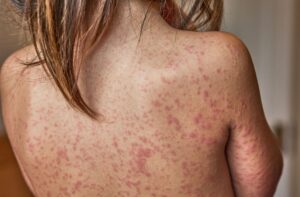
In recent years, measles cases have increased, sparking concerns among healthcare professionals and the general public alike. Once considered nearly eradicated in many parts of the world due to widespread vaccination efforts, this highly contagious disease has made a troubling comeback. Understanding the factors behind this resurgence and what steps you can take to protect yourself and your community is crucial.
Why Are Measles Cases Increasing?
Several key factors have contributed to the rise in measles cases:
- Declining Vaccination Rates – One of the primary reasons for the increase in measles cases is a drop in vaccination rates. Misinformation about vaccine safety, fueled by social media and misinformation campaigns, has led to a decline in immunization coverage in certain populations.
- Global Travel – Measles is highly contagious and spreads quickly in unvaccinated communities. With international travel rebounding in the wake of the COVID-19 pandemic, infected individuals can unknowingly carry the virus across borders, leading to outbreaks in areas where vaccination coverage is lower.
- Gaps in Public Health Infrastructure – Some regions have limited access to vaccines and healthcare services, making it difficult to maintain high immunization rates. Economic and political instability can further exacerbate these challenges.
What Are the Symptoms of Measles?
Measles often begins with flu-like symptoms, including:
- High fever
- Cough
- Runny nose
- Red, watery eyes
A few days later, a characteristic red rash appears, starting on the face and spreading downward across the body. Measles can lead to serious complications, such as pneumonia, encephalitis (brain swelling), and even death, particularly in young children, pregnant women, and immunocompromised individuals.
How Measles Effect the Skin
Having measles has several effects on the skin, most notably the characteristic measles rash. Here’s what happens:
- Early Symptoms Before Rash (Prodromal Stage)
- Before the rash appears, measles typically causes Koplik spots—tiny white spots with a red halo—inside the mouth, usually on the inner cheeks.
- The Measles Rash (Exanthem Stage)
- Appears 3–5 days after the first symptoms (fever, cough, runny nose, conjunctivitis).
- Begins as flat red spots (macules) on the face, especially around the hairline, then spreads downward to the neck, trunk, arms, legs, and feet.
- The rash may merge into larger patches as it spreads.
- The skin can look inflamed and blotchy.
- Accompanied by high fever (often over 104°F).
- Resolution & Post-Rash Effects
- After 5–6 days, the rash fades in the same order it appeared (face first, then downwards).
- Skin may shed (desquamation), leaving a temporary brownish discoloration (hyperpigmentation).
- Complications Affecting the Skin
- Superimposed bacterial infections, such as impetigo or abscesses, may occur due to weakened immunity and skin barrier disruption.
- In severe cases, measles can lead to skin ulceration or necrosis, particularly in malnourished individuals.
Permanent Effects on the Skin
Most skin effects from measles are temporary, but in some cases, permanent changes can occur. These include:
- Post-Inflammatory Hyperpigmentation (PIH) or Hypopigmentation
- After the measles rash fades, some individuals, especially those with darker skin tones, may develop persistent dark (hyperpigmentation) or light (hypopigmentation) spots where the rash was.
- These discolorations usually fade over months but can be permanent in some cases.
- Scarring
- If the measles rash becomes secondarily infected (e.g., by scratching or bacterial superinfection like impetigo), it can lead to scarring. Our aestheticians are skilled at reducing the effects of facial scarring.
- Severe complications, such as skin ulceration or necrosis, can also result in permanent scarring.
- Changes in Skin Texture
- In rare cases, prolonged inflammation from measles can cause skin atrophy or textural changes, making the affected areas appear slightly different from the surrounding skin.
- Rare Long-Term Effects: Vitamin A Deficiency & Skin Dryness
- Severe measles cases, particularly in malnourished children, can lead to Vitamin A deficiency, which may cause long-term dry skin, rough texture, or keratinization disorders.
Although these effects are rare, they underscore the importance of vaccination and proper skin care during recovery.
How Is Measles Treated?
There is no specific antiviral treatment for measles, but doctors focus on supportive care to help manage symptoms and prevent complications. Treatment options include:
- Fever and Pain Management – Over-the-counter medications such as acetaminophen or ibuprofen can help reduce fever and discomfort.
- Hydration – Drinking plenty of fluids helps prevent dehydration, which is common in measles patients.
- Rest – Getting adequate rest supports the immune system in fighting the virus.
- Vitamin A Supplementation – In some cases, particularly in children, doctors may prescribe high doses of vitamin A, which has been shown to reduce the severity and complications of measles.
- Monitoring for Complications – In severe cases, hospitalization may be required for patients who develop pneumonia, encephalitis, or other serious complications.
How Can You Protect Yourself and Your Community?
- Vaccination – The best way to prevent measles is through vaccination. The MMR (measles, mumps, and rubella) vaccine is safe and highly effective, providing lifelong immunity in most cases.
- Herd Immunity – High vaccination rates help protect those who cannot be vaccinated, such as infants and people with certain medical conditions. Ensuring widespread immunity reduces the likelihood of outbreaks.
- Stay Informed – Rely on reputable sources such as the Centers for Disease Control (CDC for vaccine and public health information. Misinformation can be dangerous, so it’s essential to fact-check before sharing health-related news.
- Seek Medical Attention If Exposed – If you suspect exposure to measles, contact a healthcare provider immediately. Early detection and isolation can prevent further spread of the virus.
Final Thoughts
The rise in measles cases is a preventable crisis. By prioritizing vaccination, spreading accurate information, and maintaining strong public health initiatives, we can curb the resurgence of this dangerous disease. As healthcare professionals, parents, and community members, it is our responsibility to protect ourselves and those around us from measles and other preventable illnesses.
For more information or to schedule a vaccination, consult your primary healthcare provider.







